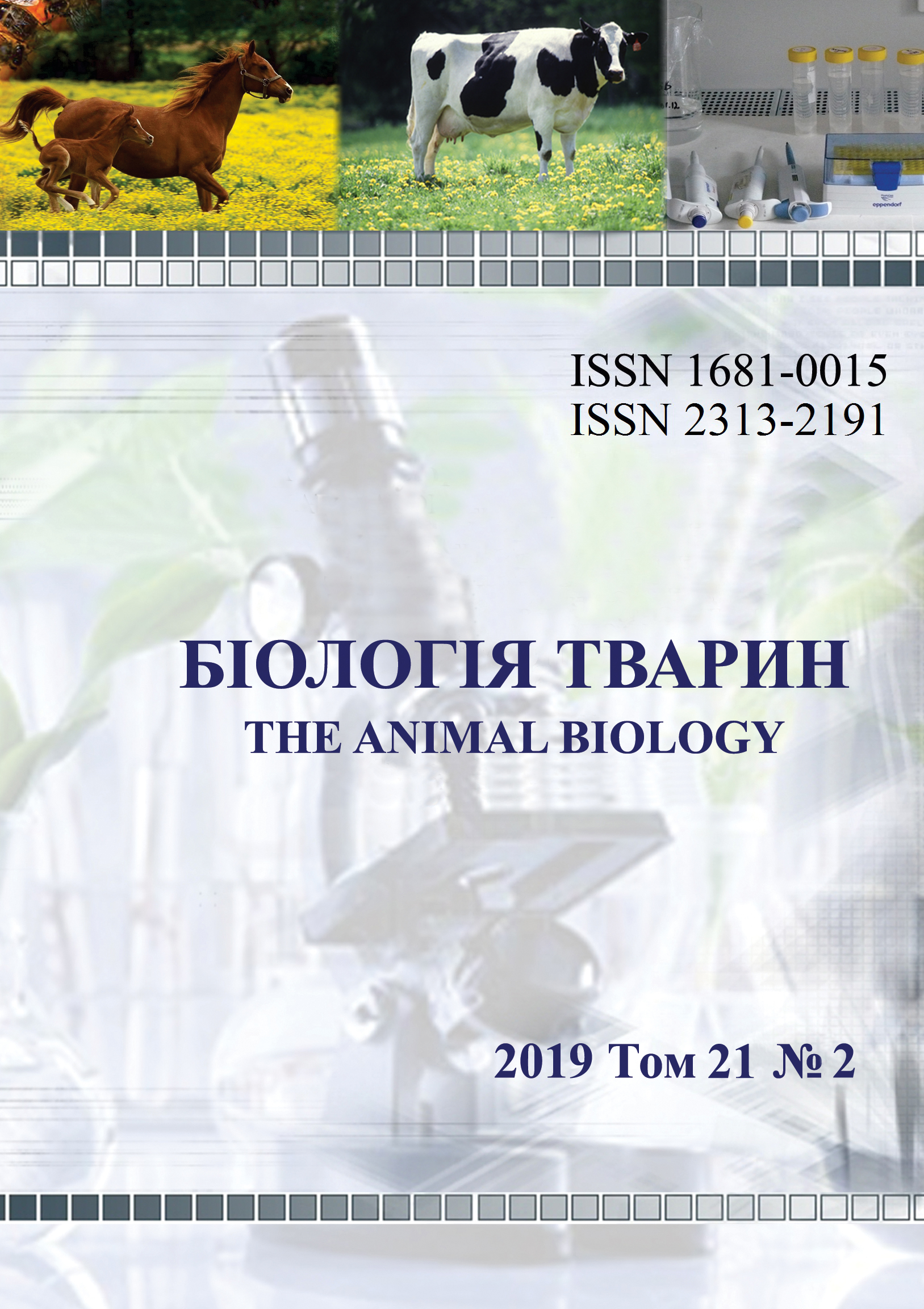Bìol. Tvarin, 2018, volume 20, issue 1, pp. 110–115
FEATURES OF MICROBIOCENOSIS OF THE POULTRY ORGANISM WITH THE MIXED PASTEURELLOSIS AND ASCARIDOSIS DISEASE
V. M. Plys
This email address is being protected from spambots. You need JavaScript enabled to view it.
State Institute of Crops NAAS of Ukraine,
14 Vernadsky str., Dnipro 49027, Ukraine
The purpose was to study the quantitative composition of microorganisms at the mixed pasteurellosis and ascaridosis disease of poultry. The article presents the results of microbiological monitoring and quantitative composition of microorganisms studied by the mixed pasteurellosis and ascaridosis disease of poultry during 2012–2016. The research was conducted on the basis of the National Scientific Center “Institute of Experimental and Clinical Veterinary Medicine” in the laboratory of epizootology of bacterial diseases of poultry, the State Institution Institute of Agriculture of the Steppe Zone of the National Academy of Agrarian Sciences of Ukraine in the laboratory of veterinary medicine, the private sector and agribusiness of various forms of ownership of the Dnipropetrovsk, Zaporizhzhya, Poltava, Mykolaiv and Vinnytsya regions. The dynamics of microbial contamination of poultry by the mixed pasteurellosis and ascaridosis disease forms depending on the course was studied.
A pathological anatomical dissection of 2,300 corpses of the dead bird was carried out. The material for the study was dead poultry of various species and age groups. Agricultural poultry (chickens, turkeys, geese, ducks) and young (chickens, turkeys, goslings, ducklings), wild migratory (wild ducks), synanthropic (pigeons and doves) and ornamental birds (wavy parrots and young wavy parrots) were subjected to research.
In order to isolate the causative agent of pasteurellosis (cholera), the birds were sown from parenchymatous organs (heart, liver, spleen, gall bladder, kidney) and red bone marrow to simple, enriched and differential diagnostic nutrient media purchased from “Region” (Dnipro), producing countries: Ukraine, India. Bacteriological studies were carried out by methods commonly accepted in microbiology. Labinskaya “Microbiology with the technique of microbiological research”, the determinant of bacteria “Berdzhi”. The biological test was placed on laboratory animals and birds according to generally accepted procedures. Parasitological studies were carried out by helminthoscopy of the test samples by the Füllbörn method.
Out of the pathological material of the fallen bird with a pasteurello-ascaridiosis mixed disease, 734 cultures of microorganisms were isolated. It has been found that the mostly isolated from pathological material composition of the microflora were Escherichia coli, Pseudomonas aeruginosa, Staphylococcus aureus, Enterococcus faecalis, Proteus vulgaris, Streptococcus zooepidemicus, Citrobacter amalonaticus, Erysipelothrix rhusiopathiae, Klebsiella pneumoniae. It should be noted that the most common contaminants were these kinds of microorganisms: Escherichia coli, Pseudomonas aeruginosa, Staphylococcus aureus, Enterococcus faecalis and Proteus vulgaris, where the first place was occupied by Escherichia coli which averaged about 40 %.
It has been established that a significant number of microorganisms was isolated by acute flow which reached up to 46 % and prevailed by frequency following types of microorganisms: Escherichia coli, Pseudomonas aeruginosa, Staphylococcus aureus, Proteus vulgaris, Enterococcus faecalis. In the chronic form of the mixed disease microflora composition was on average 45 % and Escherichia coli, Pseudomonas aeruginosa, Staphylococcus aureus were dominant.
Keywords: POULTRY, MICROFLORA, MIXED DISEASES, HELMINTHS, CONTAMINATION
-
Berezovsky A. V., Herman V. V., Fotina T. I., Fotini G. A. Avian diseases. A tutorial. Kyiv, LLC “DIA”, 2012, pp. 7–131. (in Ukrainian)
-
Heddleston K. L., Hitchner S. B., Domermuth C. H., Purchase H. G., Williams J. E. Isolation and Identification of Avian Pathogens. American Association of Avian Pathologists, Kennet Square, PA, 1975, pp.38–51.
-
Herman V. V., Stegniy B. T., Verbitsky P. I. Handbook of poultry diseases. Kharkiv, Folio, 2002, pp. 11–70. (in Ukrainian)
-
Korovin R. N. Directory on veterinary doctor poultry enterprise. St. Petersburg, vol. 1, 1995, 3p. (in Russian)
-
Labynskaya A. S. Microbiology with microbiological research. Moscow, Medicine, 1978, 394p. (in Russian)
-
Plys V. M. The mixed pasteurellosis and ascaridisosis disease of poultry. Dnipro, Zhurfond, 2017, pp. 27–38 (in Ukrainian)
-
Plys V. M., Shendryk L. I. Epizootological monitoring and pathological changes pasteurellosis (Cholera) poultry in association with some infestations. Scientific Bulletin of Lviv National University of Veterinary Medicine and Biotechnology named after S. Z. Gzhytsky, 2014, vol. 16, no. 2(59), pp. 262–270. (in Ukrainian)
-
Plys V. M., Fotina T. I. Epizootological monitoring, clinical signs and pathological changes pasteurellosis (Cholera) poultry associations with certain infectious and parasitic diseases. Bulletin of Sumy National Agrarian University, 2014, no. 6 (35), pp. 114–122. (in Ukrainian)
-
Pokrovsky V. I., Podeev O. K. Medical microbiology. Moscow, GOETAR, Medicine, 1999, 120 p. (in Russian)
-
Priskoka A. V., Dostoevsky P. P., Borziak A. T. Parasitecenosis as an etiological factor mixed infections. Kyiv, 1995, pp. 19–20. (in Ukrainian)
-
StegniyB.T., Sikachyna V. I., Plys V. M., Obukhovska O. V., Kolbasina T. V. Methodical guidelines for the diagnosis, prevention and control measures pasteurellosis (Cholera) of poultry. Dnepropetrovsk, 2009, pp. 3–38. (in Ukrainian)
-
Rimler R. B. Presumptive identification of
Pasteurella multocida serogroups A, D and F by capsule depolymerisation with mucopolysaccharidases.
Vet. Rec., vol. 134, 1994, pp. 191–192.
https://doi.org/10.1136/vr.134.8.191
-
The determinant of Berjee bacteria. Ed. by J. Hoult. Moscow, The World, 1997, vol. 1–2. pp. 5–273.
Download full text in PDF
 Bìol. Tvarin. 2018; 20 (1)
Bìol. Tvarin. 2018; 20 (1)![]() FULL ISSUE
FULL ISSUE













